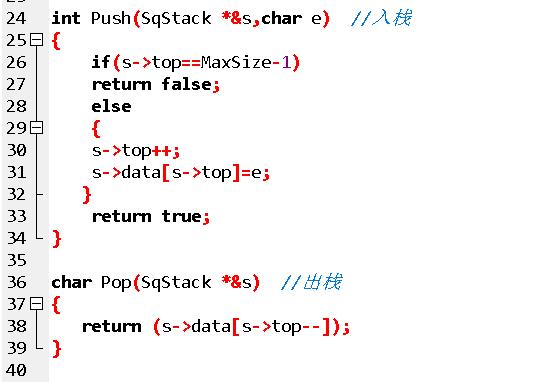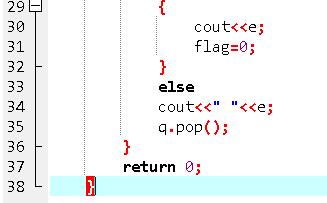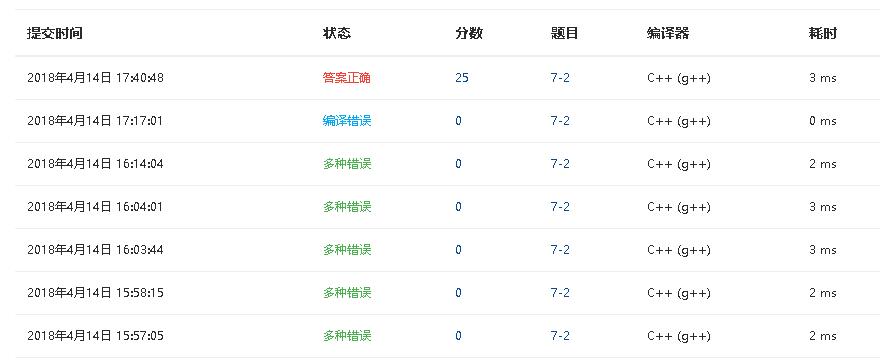博客作业03--栈和队列
1.学习总结(2分)

2.PTA实验作业(4分)
题目1:7-1 jmu-字符串是否对称
设计思路
自定义栈结构体
初始化栈InitStack(SqStack *&s)
入栈Push(SqStack *&s,char e)
出栈char Pop(SqStack *&s)
主函数:
定义栈s并初始化
定义字符数组str[]
输入字符串到数组中
for i=0 str[i]!='\0'
字符串入栈
for j=0 str[j]!='\0'
如果str[j]与出栈元素不相等
flag=false
end
若字符串对称 输出yes
否则,输出no
代码截图



PTA提交列表说明

编译错误是编译器是c,改成c++,段错误是输入格式错误了
题目2:jmu-报数游戏
设计思路
输入m,n
for i=0 to n
if n<m
输出error
end
while 队列非空
报到m的人减1
while队列还非空
e存入队列元素
先出队,再将存入e的元素进队
flag判断空格,if 是空格
输出e
flag=0
否则,输出空格再输出e
最后出队
end
代码截图


PTA提交列表说明

题目3:银行业务队列简单模拟
设计思路
定义 n为总量,a为顾客编号,i,t=0判断窗口
输入n
模板类定义队列p,q
for i=0 t on
输入a
if是奇数,进队p
if是偶数,进队q
while队p或q不为空
t++
if队列p非空
输出p队头并入队
if p或q非空 输出空格
else
if队列p非空
输出p队头并入队
if 队列q非空
输出q队头并入队
输出空格
输出\n
end
代码截图


PTA提交列表说明

开始用了数组,但发现有运行超时,后把数组去掉了,while里面队列q非空少了!,答案错误,纠结了一下午
3.截图本周题目集的PTA最后排名
3.1 栈PTA排名

3.2 队列PTA排名

3.3 我的总分:140
4. 阅读代码
求解迷宫问题
1.栈
#include<stdio.h>
#include<stdlib.h>
#include<malloc.h>
#include<iostream>
#define MaxSize 100
//①、定义一个顺序栈;
typedef struct
{ int i;
int j;
int di;
} Box;
typedef struct
{ Box data[MaxSize];
int top;
} StType;
//②、编写走出迷宫代码;
bool mgpath(int xi,int yi,int xe,int ye)
{ int i,j,k,di,find;
StType st;
st.top=-1;
st.top++;
st.data[st.top].i=xi; st.data[st.top].j=yi;
st.data[st.top].di=-1; mg[xi][yi]=-1;
while (st.top>-1)
{ i=st.data[st.top].i;j=st.data[st.top].j;
di=st.data[st.top].di;
if (i==xe && j==ye)
{ printf("迷宫路径如下:\n");
for (k=0;k<=st.top;k++)
{ printf("\t(%d,%d)",st.data[k].i,st.data[k].j);
if ((k+1)%5==0)
printf("\n");
}
printf("\n");
return true;
}
find=0;
while (di<4 && find==0)
{ di++;
switch(di)
{
case 0:i=st.data[st.top].i-1;j=st.data[st.top].j;
break;
case 1:i=st.data[st.top].i;j=st.data[st.top].j+1;
break;
case 2:i=st.data[st.top].i+1;j=st.data[st.top].j;
break;
case 3:i=st.data[st.top].i,j=st.data[st.top].j-1;
break;
}
if (mg[i][j]==0) find=1;
}
if (find==1)
{ st.data[st.top].di=di;
st.top++;
st.data[st.top].i=i; st.data[st.top].j=j;
st.data[st.top].di=-1;
mg[i][j]=-1;
}
else
{ mg[st.data[st.top].i][st.data[st.top].j]=0;
st.top--;
}
}
return false;
}
得到迷宫路径如下:
(1,1) (1,2) (2,2) (3,2) (3,1)
(4,1) (5,1) (5,2) (5,3) (6,3)
(6,4) (6,5) (5,5) (4,5) (4,6)
(4,7) (3,7) (3,8) (4,8) (5,8)
(6,8) (7,8) (8,8)
2.队列
#include<stdio.h>
#include<stdlib.h>
#include<malloc.h>
#include<iostream>
#define MaxSize 100
//①、定义一个顺序栈;
typedef struct
{ int i,j;
int pre;
} Box;
typedef struct
{ Box data[MaxSize];
int front,rear;
} QuType;
//②、编写走出迷宫代码;:
bool mgpath1(int xi,int yi,int xe,int ye)
{ int i,j,find=0,di;
QuType qu;
qu.front=qu.rear=-1;
qu.rear++;
qu.data[qu.rear].i=xi; qu.data[qu.rear].j=yi;
qu.data[qu.rear].pre=-1;
mg[xi][yi]=-1;
while (qu.front!=qu.rear && !find)
{ qu.front++;
i=qu.data[qu.front].i; j=qu.data[qu.front].j;
if (i==xe && j==ye)
{ find=1; print(qu,qu.front); return true; }
for (di=0;di<4;di++)
{ switch(di)
{
case 0:i=qu.data[qu.front].i-1;
j=qu.data[qu.front].j; break;
case 1:i=qu.data[qu.front].i;
j=qu.data[qu.front].j+1; break;
case 2:i=qu.data[qu.front].i+1;
j=qu.data[qu.front].j; break;
case 3:i=qu.data[qu.front].i;
j=qu.data[qu.front].j-1; break;
}
if (mg[i][j]==0)
{ qu.rear++;
qu.data[qu.rear].i=i; qu.data[qu.rear].j=j;
qu.data[qu.rear].pre=qu.front;
mg[i][j]=-1;
}
}
}
return false;
}
得到迷宫路径如下:
(1,1)(2,1)(3,1)(4,1)(5,1)
(5,2)(5,3)(6,3)(6,4)(6,5)
(7,5)(8,5)(8,6)(8,7)(8,8)



